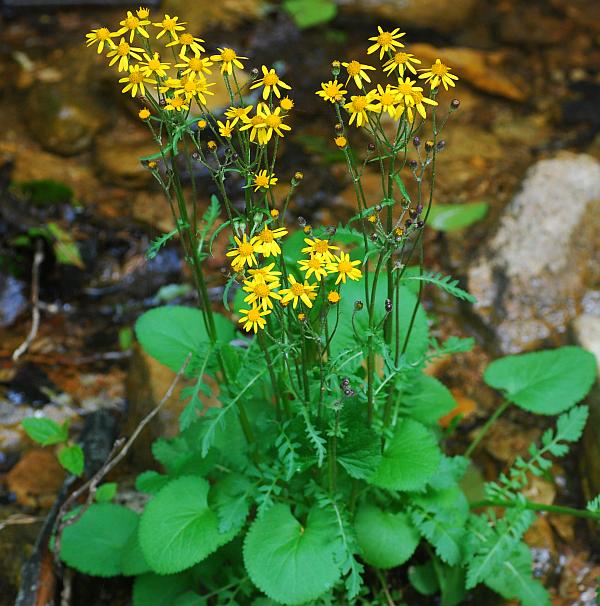Packera aurea (L.) . Lve & D. Lve
Golden Ragwort

Native
CC = 6
CW = -3
MOC = 46
© SRTurner
Packera aurea (L.) . Lve & D. LveGolden Ragwort | |
 |
Native CC = 6 CW = -3 MOC = 46 |
© SRTurner |
|
Family - Asteraceae/Senecioneae Habit - Perennial forb, from a short, stout to slender, ascending to horizontal, often branched rootstock, sometimes producing a few stolons. Stems - Erect, to 80 cm, mostly 1, occasionally 2 or 3, sometimes pubescent with felty or cobwebby hairs toward the base when young, but usually glabrous or nearly so at flowering.
Leaves - Alternate and basal. Basal leaves long-petiolate, the petioles sometimes woolly or cobwebby when young, usually glabrous or nearly so at flowering, the blades 1-11 cm long, unlobed or rarely with few narrow, irregular lobes toward the base, oblong-ovate to nearly circular, truncate and at least some deeply cordate at the base, the tissue extending at most only along the terminal portion of the petiole, rounded at the tip, the margins with blunt to sharp teeth, the surfaces shiny deep-green above, light green below, glabrous or sparsely pubescent. Stem leaves gradually reduced toward the stem tip, sessile or nearly so, the blades mostly deeply pinnately lobed, sometimes irregularly so, occasionally pinnately compound, the margins otherwise relatively sharply toothed, the surfaces glabrous.
Inflorescence - Terminal and axillary panicles of flower heads to 10 cm broad, usually flat-topped. Peduncles carinate, glabrous or sparsely arachnoid-pubescent. Inflorescence divisions subtended by linear-subulate bracts, these with some arachnoid pubescence near the base.
Heads - Radiate. Receptacle flat. Involucres cylindrical, 4-8 mm long, glabrous or very sparsely hairy near the base, the phyllaries linear, sparsely arachnoid-pubescent externally, glabrous internally, acute, nearly uniseriate but with a few small bracts at the base.
Florets - Ray florets 7-13 per head, the ligule yellow, 6-13 long, oblong-elliptic, 3-toothed at the apex, glabrous, the tube 4 mm long, white, glabrous. Style yellow apically, white basally, bifurcate, exserted for about 1 mm. Disk 7 mm broad, the corolla tube 5-6 mm long, white basally, yellow apically, contracted in the basal 2/3-3/4, expanded at the apex, glabrous in and out, 5-lobed. Lobes acute spreading, 0.75 mm long and broad, triangular. Stamens 5, adnate at the base of the expanded portion of the corolla tube. Filaments 1.2 mm long, glabrous, translucent-white, very thin at the base, expanded in the apical portion. Anthers 2 mm long, yellow, connate around the style. Style partially exserted beyond the anthers, glabrous, whitish basally, yellow apically, to 7 mm long, bifurcate in the apical 1 mm. Both floret types with pappus of white capillary bristles, to 5 mm long.
Fruits - Achenes 2.5-3.0 mm long, glabrous. Flowering - April - June. Habitat - Streambanks, spring branches, fens, seepy ledges of bluffs, bottomland forests, wooded ravines. Origin - Native to the U.S. Lookalikes - Other species of Packera, especially P. pseudaurea. Other info. - This striking species is found in Missouri mainly in the Ozark region. Beyond Missouri its range extends throughout most of the eastern half of the U.S., except for the far south, and into Canada. It is relatively easily identified by its showy inflorescences of yellow-rayed heads, large basal leaves with cordate bases, and wet habitat. However, distinguishing this species from the closely related P. pseudaurea is difficult. That species tends to have basal leaves which are more ascending with narrower and less cordate blades, and less purple coloration on the involucral bracts. Photographs taken at Whetstone Creek Conservation Area, Callaway County, MO., 5-4-04 (DETenaglia); also at St. Francois State Park, 5-2-2010, and Danville Conservation Area, 4-25-2017 (SRTurner). |